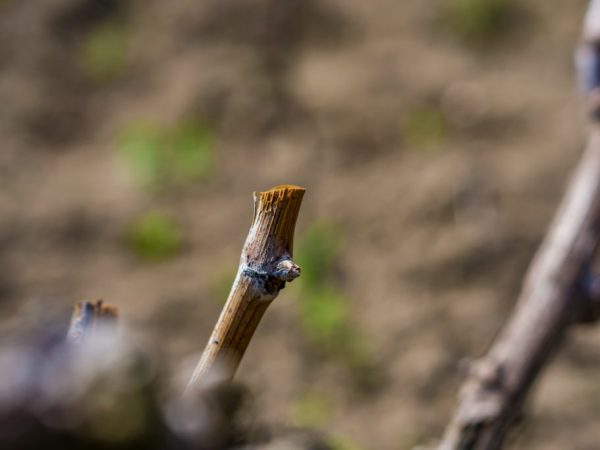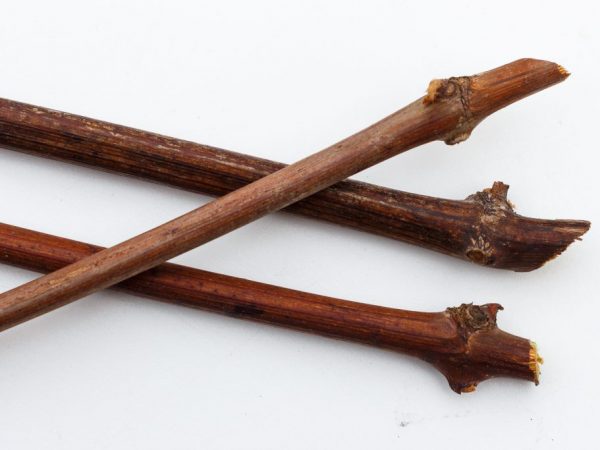The technology of planting grapes by cuttings without roots
In a favorable climate, it is permissible to plant grapes with cuttings without roots. This method is distinguished by a longer survival period, but it makes it possible to plant a garden culture without first rooting the cuttings.

The technology of planting grapes by cuttings without roots
Cons of the method
When unrooted cuttings are planted, the probability of their survival is markedly reduced. The plant develops in soil at a slower rate compared to seedlings planted with pre-rooting. This is due to the fact that the plant at the initial stage needs to direct all its forces to the development of the root system.
It is permissible to increase the survival rate by selecting high-quality planting material and its subsequent processing.
Procurement of planting material and its storage
Cuttings, called shanks, are cuttings from a fruiting vine that is one year old. A plant not affected by diseases without mechanical damage on the surface of the bark is suitable as a donor.
The maturity of the vine is determined using a 1% iodine solution, where the cut is lowered. In an unripe vine, the color changes to light green; in a fully ripe vine, it becomes violet-black.
Chubuki are harvested when pruning the vine in the fall, after the leaves fall, but before the onset of the first frost, which usually falls on October-November.
Sections are cut from the donor vine from the lower or middle part, where the diameter of the branch is 6-12 mm. The length of each shank is 20-50 cm. A prerequisite is the presence of at least 2-3 developed buds on the selected segment.
Longer shanks are recommended: they have better reproductive results. Those with 5-6 buds are preserved during the winter better; when disembarking, it is permissible to divide them in half.
The cut cuttings are wrapped in polyethylene and stored at a temperature of 0 ° C-5 ° C, for which a refrigerating chamber, a basement room, a hole dug to a depth of 25-30 cm, sprinkled with straw and soil are suitable.
Before storage, the shanks are recommended to be kept in water for a day to gain moisture.
The material is regularly inspected for the appearance of mold and rot, the affected is thrown away. With the development of mold, the plant is treated with potassium permanganate, dried and sent back for storage. The main task is to create conditions under which the cuttings did not grow ahead of schedule.
Planting time
For planting grapes with cuttings without roots, unlike planting already rooted seedlings, autumn is not suitable, since the vine will not have time to take root and gain strength for the upcoming wintering. The only time to plant the shanks is spring.
The term for grafting depends on the climatic characteristics of a particular region taken, therefore, they are guided by an increase in temperature. The optimal time to plant seedlings without roots is the period when the soil warms up to a depth of 0.25-0.3 m to 10 ° C and above. This time is:
- in the southern regions - at the end of March - mid-April,
- in the central region - in early April-early May,
- in the northern districts - at the end of April and the last days of May.
Planting unrooted cuttings justifies itself when there is no risk of sudden frosts, otherwise seedlings without formed roots will die.
Technology

Cuttings must be prepared for planting
Planting technology includes several stages.
Training
Disembarkation of shanks after winter storage begins with a preparatory stage. It involves removing them from a state of dormancy, which gives the plant the opportunity to increase survival rate and begin the stage of active growth earlier. In preparation:
- assess the suitability of the preserved stems by making incisions on the bud and on the twig itself, while the bud should be green and the vine should not be dry,
- the sorted material is washed in a weakly concentrated potassium permanganate in order to disinfect,
- soak the treated shanks in water for 1-2 days so that the water covers more than 1/3 of the length,
- cuttings are treated with stimulants to enhance the root formation processes, additionally making 3-4 longitudinal scratches to speed up this process.
Seat selection
For a warm-loving grape, choose a suitable place:
- in northern areas and in the regions of the middle lane, these are spacious areas where a large amount of sunlight enters, at the same time protected against the winds by trees and shrubs planted around the perimeter,
- in regions with frequent rains, these are slopes or bulk hills,
- in arid areas, these are areas located near the passage of groundwater.
On flat planting areas, grape cuttings are planted in the direction from north to south at a distance of 2-2.5 m from the walls of houses and other buildings, preferably from the south.
Disembarkation scheme
Recommended scheme for planting grapes with cuttings without roots:
- on chernozem soils - in pits 0.6 * 0.6 * 0.6 cm,
- on loamy soils - in pits 0.8 * 0.8 * 0.8 cm,
- on sandstones - in pits 1 * 1 * 1 m.
Many people practice planting unrooted cuttings first in the garden, and at the end of the formation of the roots, move them to a permanent place of growth.
Fertilizers are spread on the bottom in 1 level with a layer of up to 0.3 m, a grape shank is installed, leaving the upper peephole at a level of 5 cm below the ground level and covered with earth with a layer of up to 0.5 m.Each stalk is watered with 40-50 liters of water. After it has been absorbed into the pit, the earth is poured and tamped, leaving a small hole.
For safety net, 2 cuttings are planted simultaneously in 1 hole. If both take root, one of them is removed, transplanted to a new place.
Instead of separately dug holes, it is permissible to plant cuttings in one trench, placing them at an angle of 45 °.
Recommended spacing between bushes:
- when growing vigorous varieties - not less than 3-3.5 m,
- when growing medium-sized varieties - up to 3 m,
- when growing low-growing grapes - up to 2.5 m.
Simultaneously with the landing, supports are made. To create additional warmth in areas with a cool climate, the planted shanks are covered with foil or a mini-greenhouse is arranged. In artificially keeping warm conditions, cuttings take root much faster.
Conclusion
It is permissible to plant grapes in open soil with unrooted cuttings. The technology is less effective, however, when additional conditions are created, subject to the planting scheme, it gives positive results.


